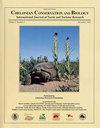在墨西哥湾西北部被休闲渔具偶然捕获的坎普雷德利海龟的饮食
IF 0.8
4区 生物学
Q3 ZOOLOGY
引用次数: 12
摘要
2005-2008年在美国德克萨斯州加尔维斯顿县采集了21只未成熟的Kemp's ridley海龟(Lepidochelys kempii),这些海龟是偶然捕获或在休闲鱼钩渔具中纠缠的。海龟主要食用游蟹(普通蓝蟹、绿蟹和绿蟹属)、行蟹(红蟹、绿蟹;地中海波斯福纳花蟹;寄居蟹)和多毛类蠕虫管。大藻(马尾藻属)也被近一半的采样海龟食用,可能是偶然的,也可能是底栖动物的碎屑。德克萨斯州上海岸和当地的捕鱼码头为未成熟的肯普雷德利提供了多种觅食机会,但也使该物种面临与人类活动相互作用的风险,包括渔具相互作用和摄入人为碎片。本文章由计算机程序翻译,如有差异,请以英文原文为准。
Diet of Kemp's Ridley Sea Turtles Incidentally Caught on Recreational Fishing Gear in the Northwestern Gulf of Mexico
Abstract Twenty-one immature Kemp's ridley sea turtles (Lepidochelys kempii) were collected following incidental capture or entanglement in recreational hook-and-line gear during 2005–2008 in Galveston County, Texas, United States. Turtles consumed primarily swimming crabs (common blue crab, Callinectes sapidus, and Callinectes spp.), walking crabs (calico box crab, Hepatus epheliticus; mottled purse crab, Persephona mediterranea; and hermit crabs), and polychaete worm tubes. Macroalgae (Sargassum spp.) was also consumed by nearly half of the sampled turtles, presumably incidentally and likely as benthic detritus. The upper Texas coast and local fishing piers provide diverse foraging opportunities for immature Kemp's ridleys but also put the species at risk for interactions with human activities, including gear interactions and ingestion of anthropogenic debris.
求助全文
通过发布文献求助,成功后即可免费获取论文全文。
去求助
来源期刊
CiteScore
1.70
自引率
14.30%
发文量
17
审稿时长
>12 weeks
期刊介绍:
Chelonian Conservation and Biology is a biannual peer-reviewed journal of cosmopolitan and broad-based coverage of all aspects of conservation and biology of all chelonians, including freshwater turtles, marine turtles, and tortoises. Manuscripts may cover any aspects of turtle and tortoise research, with a preference for conservation or biology. Manuscripts dealing with conservation biology, systematic relationships, chelonian diversity, geographic distribution, natural history, ecology, reproduction, morphology and natural variation, population status, husbandry, community conservation initiatives, and human exploitation or conservation management issues are of special interest.

 求助内容:
求助内容: 应助结果提醒方式:
应助结果提醒方式:


